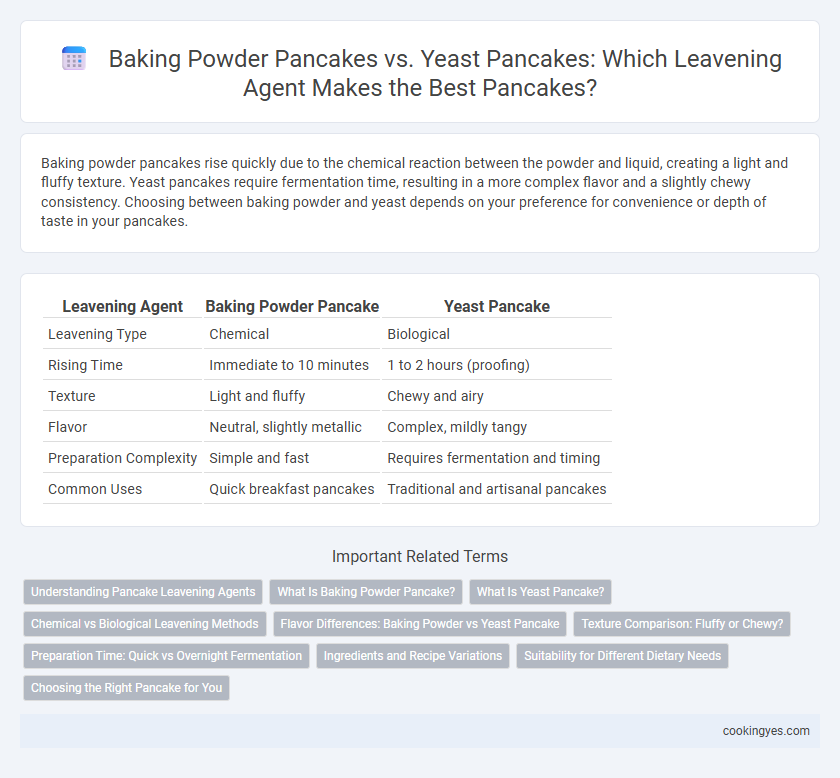Baking powder pancakes rise quickly due to the chemical reaction between the powder and liquid, creating a light and fluffy texture. Yeast pancakes require fermentation time, resulting in a more complex flavor and a slightly chewy consistency. Choosing between baking powder and yeast depends on your preference for convenience or depth of taste in your pancakes.
Table of Comparison
| Leavening Agent | Baking Powder Pancake | Yeast Pancake |
|---|---|---|
| Leavening Type | Chemical | Biological |
| Rising Time | Immediate to 10 minutes | 1 to 2 hours (proofing) |
| Texture | Light and fluffy | Chewy and airy |
| Flavor | Neutral, slightly metallic | Complex, mildly tangy |
| Preparation Complexity | Simple and fast | Requires fermentation and timing |
| Common Uses | Quick breakfast pancakes | Traditional and artisanal pancakes |
Understanding Pancake Leavening Agents
Baking powder pancake batter relies on chemical leavening agents, producing carbon dioxide quickly for light and fluffy pancakes with a tender crumb. Yeast pancake batter ferments over time, developing complex flavors and a slightly chewy texture due to natural gas production during fermentation. Understanding these leavening differences helps tailor pancake recipes to desired texture and flavor profiles.
What Is Baking Powder Pancake?
Baking powder pancakes rely on a chemical leavening agent composed of an acid and a base that reacts with moisture and heat to produce carbon dioxide, creating a light and fluffy texture. This method allows for quick preparation since the batter rises immediately without the need for fermentation time. Baking powder pancakes have a neutral flavor and consistent rise, making them a popular choice for a simple, fast breakfast.
What Is Yeast Pancake?
Yeast pancakes are made using yeast as a natural leavening agent, which ferments the batter causing it to rise slowly and develop a distinctive airy texture and slightly tangy flavor. Unlike baking powder pancakes that rely on chemical leavening for quick rise, yeast pancakes require longer fermentation time, allowing natural yeast to produce carbon dioxide and create light, fluffy layers. This slow fermentation process also enhances the pancake's digestibility and provides a richer, more complex taste profile.
Chemical vs Biological Leavening Methods
Baking powder pancakes rely on chemical leavening, where a mixture of acid and alkaline compounds produces carbon dioxide gas rapidly when heated, resulting in a light and fluffy texture. Yeast pancakes use biological leavening, involving the fermentation process where yeast metabolizes sugars and releases carbon dioxide over a longer period, creating a more complex flavor and chewier texture. Chemical leavening with baking powder offers quicker preparation, while biological leavening with yeast demands time but enhances taste and texture depth.
Flavor Differences: Baking Powder vs Yeast Pancake
Baking powder pancakes offer a light, tender texture with a mild, neutral flavor that allows toppings to shine, while yeast pancakes develop a deeper, more complex taste featuring subtle tangy and fermented notes due to the yeast fermentation process. Yeast pancakes often have a chewier consistency and a slightly airy crumb compared to the fluffier, quicker-rise texture of baking powder pancakes. The natural fermentation in yeast pancakes enhances flavor complexity, making them ideal for those seeking a richer pancake experience.
Texture Comparison: Fluffy or Chewy?
Pancakes made with baking powder typically exhibit a light, fluffy texture due to the rapid release of carbon dioxide gas creating numerous small air pockets. Yeast pancakes develop a chewier, more complex texture as the fermentation process produces gas slowly and promotes gluten development. The choice between baking powder and yeast significantly influences the pancake's final mouthfeel, with baking powder favoring tenderness and yeast enhancing elasticity.
Preparation Time: Quick vs Overnight Fermentation
Baking powder pancakes offer a quick preparation time, typically ready within minutes due to the chemical leavening agent creating immediate rise. Yeast pancakes require an overnight fermentation process, allowing natural yeast to produce carbon dioxide, resulting in a more complex flavor and airy texture. Choosing between these leavening agents depends on whether speed or depth of flavor and texture is prioritized.
Ingredients and Recipe Variations
Baking powder pancakes use chemical leavening agents like baking powder to produce quick, light, and fluffy textures, requiring minimal resting time in recipes. Yeast pancakes rely on natural fermentation, resulting in a tangier flavor and a chewier texture, often necessitating longer proofing periods for the batter. Recipe variations highlight baking powder pancakes with simple, fast preparations, while yeast pancakes incorporate ingredients like sugar and warm liquids to activate yeast fermentation for deeper flavor profiles.
Suitability for Different Dietary Needs
Baking powder pancakes provide a quick and convenient leavening option, suitable for gluten-sensitive or yeast-allergic individuals due to their chemical rise and absence of fermentation. Yeast pancakes offer a natural fermentation process, enhancing flavor and digestibility, making them ideal for those seeking probiotic benefits or a more traditional taste. Selecting between the two depends on dietary restrictions, time constraints, and desired texture, with baking powder catering to convenience and yeast appealing to gut health-conscious consumers.
Choosing the Right Pancake for You
Baking powder pancakes provide a quick, fluffy texture with an immediate rise due to the chemical leavening agents, making them ideal for fast preparation and consistent results. Yeast pancakes require longer fermentation, creating a distinct tangy flavor and a chewier, airier crumb, perfect for those who enjoy artisan-style pancakes with depth. Selecting between baking powder and yeast pancakes depends on your preference for speed and texture versus flavor complexity and traditional fermentation.
Baking Powder Pancake vs Yeast Pancake for Leavening Infographic

 cookingyes.com
cookingyes.com